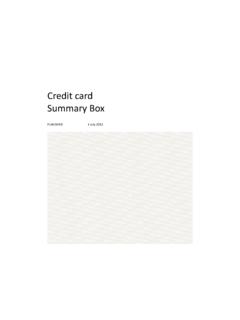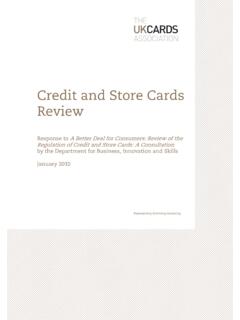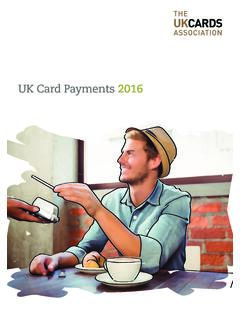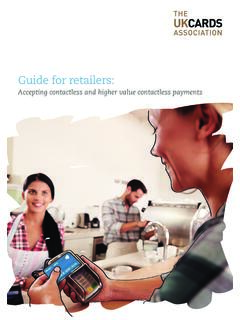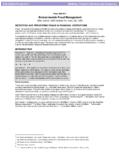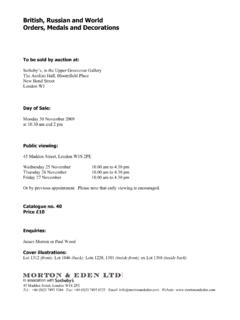Transcription of UK Card Payments 2017 - The UK Cards Association
1 UK card Payments2017UK card Payments 2017provides a comprehensive summary of howand where Cards were used in 2016. This includes data on how manycards consumers hold and what they bought with them, both in thehigh street and online. It also includes details of personal card spendinghabits, and forecasts how our use of Cards is expected to change overthe next ten of dataThe data in this report, unless otherwise stated, are compiled from information gathered from the uk Cards Association s members: UK-based issuers and institutions which process payment card transactions on behalf of UK-based merchants, retailers and other service providers. All data, unless otherwise stated, cover annual figures as at 31 December queries about the data in this publication please contact Information Management:Silvija Krupena / David Obuwa / Nigel BurtTel020 3217 For member enquiries relating to users and holders of Cards , and forecasts, please contact Research and Customer membership information or further details about the uk Cards Association please contact:Tel020 3217 UK Cards ASSOCIATIONA glossary of terms used in this publication canbe found at: are the most popular payment method in the uk by value.
2 They allow cardholders to pay for goods and services easily, convenientlyand securely. card spending accounted for 35% of GDP in 2016 and is critical for the economy. It is expected to continue to grow over thenext decade and to overtake cash as the predominant way to pay in volume as it already is in are issued by a variety of organisations such as banks, building societies and other financial services companies. The types of cardsissued and their level of functionality vary from card issuer to card issuer and between the different card schemes. The major card schemesinclude American Express, Diners Club, JCB International, Mastercard and Visa. These schemes are the operators of the card systems thatset the rules under which transactions occur, process transactions and provide a settlement function. This report looks in detail at how cardsare held and used, and includes summary tables on Cards in issue, the number and value of transactions, and point-of-sale publications from the uk Cards Association are available by contacting: more information please visit our website: UK Cards Association is the trade body for the card Payments industry in the uk , representing financial institutions which act as card issuers and Association promotes co-operation between industry participants in order to progress non-competitive matters of mutual interest; informs and engages with stakeholders to shape legal and regulatory developments; develops industry best practice; safeguards the integrity of the card Payments industry by tackling card fraud with Financial Fraud Action UK; develops industry standards.
3 And co-ordinates other industry-wide initiativessuch as those aiming to deliver innovation. As an Association we are committed to delivering a card Payments industry that is constantly focused on improved outcomes for the information about the uk Cards Association is available at: card Payments 20173 Table of Contents1 Overview of the uk card Payments background of Cards in issue and card transactions in acceptance in card future11 Key Statistics 2016142 Payment cards413 card Acceptance and card spending card fraud overview56 purchase (CNP) fraud in the face-to-face environment57 border fraud losses575 Recent Regulatory Credit card Market Fee for third parties and customer developments596 The Future of the uk card technology developments 637 International of the in terminals77 BoxesRecent trends in credit card indebtedness10 Credit card acquisition17 Multiple credit card holding20 Credit card profiles 24 Understanding credit card borrowing26 Online spending2810 years of Chip & PIN31 Consumer spending patterns online54 Take Five 57 Research and analysis58 Cyber security71UK card Payments2017 ChartsTHE UK Cards ASSOCIATION41 Overview of the uk card Payments of Cards at of credit and debit card of credit and debit card purchases of credit and debit card of credit card borrowings that are card and debit card payment volume forecasts132
4 Payment of credit and charge Cards in issue of credit and charge card holders credit card holding of credit card holders using their credit cardsat least once a month to make purchases between credit card spending and and value of credit card credit and charge Cards : card types as a percentage of card borrowings (as a proportion of household income and GDP) gross credit card lending and Write-offs as a percentage of credit card Quoted rates on unsecured consumer credit Number of debit Cards in issue by card Number of debit card debit card holding by demographic group Multiple debit card holding Adults using only debit Cards or debit and credit debit card debit card cash Contactless Cards in Contactless Contactless card transactions in Proportion of contactless Payments by merchant sectors 2016 Cards with ATM functionality413 card Acceptance and of outlets and terminals accepting payment number and value of transactions per expenditure on credit and debit Sales.
5 Proportions using debit Cards , credit and charge Cards , cash and on payment Cards by merchant sector of purchases by merchant sector changes in card spending by merchant categoriesbetween 2015 and of spending online by merchant sectors of face-to-face and online ATVs by merchantsectors 2016544 card losses on UK-issued ratios576 The Future of the uk card Cards : UK purchase and charge Cards : UK purchase forecasts617 International Number of debit and credit Cards per capita, 2006 and 2015, and debit card Payments per capita, 2006 and 2015, of debit and credit Cards per capita, 2006 and 2015, rest of the and debit card Payments per capita, 2006 and 2015, rest of the online spending per household worldwide, 2009 and acquiring top ten locations for payment card usage in 2016 and 2015 based on number of top ten locations for payment card usage in 2016 and 2015 based on value of top ten locations for payment card usage in 2016 and 2015 based on average value of with the highest and lowest proportion of online spending, 2016531.
6 Overview of the uk card Payments Market Economic backgroundCard spending has increased consistently since payment Cards were first introducedinto the uk in the 1960 s as a payment mechanism. This growth has been continuous irrespective of any underlying developments in the wider economy,such as consumer booms, recessions, or changes in government economic these factors will have had an underlying effect on consumer confidence andconsumption, their effect is masked by the overarching migration of Payments tocards from other forms of payment (typically cash and cheques). This trend continued in 2016, the economic environment was broadly favourable for consumers, eventaking into account the vote to leave the European Union. The predicted effects ofthe Brexit vote have not yet been felt credit conditions remain favourable, sustaining an increase in consumer borrowing.
7 Other key developments were: Strengthening economic growth Rising employment and earnings Strong house price inflation Increase in general price inflation in the final quarter, with the Bank of Englandforecasting that CPI inflation will stay above the 2% target in subsequent quarters Robust consumer spending in spite of weakening consumer confidence Declining borrowing costs driven by strong competition in the market Limited initial impact of industry regulatory developments (EC decision on interchange fees and the FCA study of the credit card market).In terms of outlook, the fall in sterling after the Brexit referendum impacted imports and commodity prices, resulting in higher inflation, which stood at January, rising to by the end of the year. This could increase pressure on households, potentially lowering the rate of consumer spending.
8 The full consequences of Brexit will depend on the outcome of the Article 50 creates a number of is likely that in 2016 the strong labour market offset short-term negative shocks,evident in high levels of card spending. Employment rose to the end ofthe year, its highest level since comparable records began. This coincided withunemployment falling to , a level last seen in the second half of 2005. It is,however, worth noting that any positive effects of card spending from the labourmarket may have been tempered by rising inflation, which could be reducing consumers disposable details at: details at: 3 The sharing economy involves using internet technologies to connect distributed groups of people to make better use of goods, skills and services. It allows people to communicate and share information, building trust and increasing the number of meaningful interactions.
9 Finally, many activities within the sharing economy seek to foster a spirit of openness and details at: Car sharingPeer-peerlendingMusic streamingPeer-peeraccommodationDIY tasksUK card Payments 2017 The continued relative strength of UK GDP figures (+ ) was reflected in retailsales. Retail spending grew by in 2016 to reach 388 billion with debitcards accounting for 53% of this. To put this into context, credit and charge cardsaccounted for 24% of retail spending in 2016, with cash and cheques making upthe remaining 23%. High levels of spending were also evident in the services sector, despite the sharp drop in consumer confidence following the Brexit , interest rates were cut to in response to the Brexit vote2. This is a historically low level, and there are indications that this may change in response to higher inflation in 2017 .
10 Low interest rates can be good for the economy if they encourage the cycle of bank lending, investment, employment and growth, but thereare concerns about the potential impacts of a persistent low interest rate interest rates have previously led to low mortgage and consumer credit rates, although this is also driven by competition in these markets, increasing lending in sharing economy3also continued to expand. In 2015 alone transactions in thissegment were estimated at billion4, up from billion in 2014. Going forward,it is estimated the uk s sharing economy could expand by over 30% per year overthe next decade, generating 18 billion of revenue for platforms and facilitating about 140 billion worth of transactions per year by 2025. Activity has been concentrated inparticular sectors, such as transportation, finance, accommodation and on-demandhousehold consumption.
